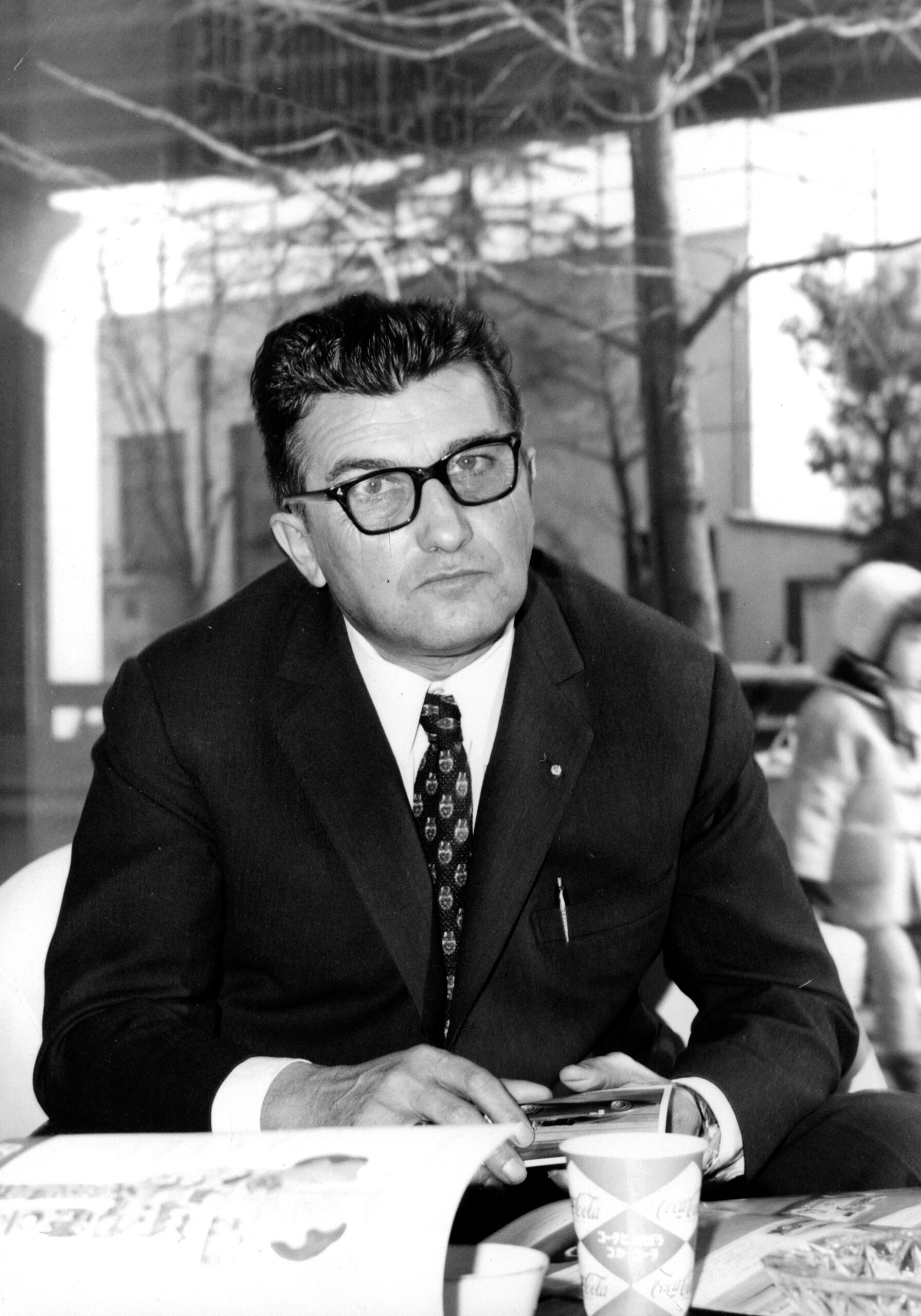Lamborghini – The Man Behind the Legend had its global premiere at the Rome Film Festival. Set in 1950s Italy, the film, penned and directed by Bobby Moresco, Oscar winner for Crash, was released in Italy in January, just days before the thirtieth anniversary of the passing of Ferruccio Lamborghini, the founder of one of the world’s most celebrated automobile brands. Playing the role of the visionary entrepreneur is actor Frank Grillo. In his early thirties, Ferruccio ventured into manufacturing agricultural equipment, launching Lamborghini Trattori. Yet, his passion for sports cars ultimately led him to establish Lamborghini Automobili, a journey that placed him in direct rivalry with Enzo Ferrari.
Remaining in the cinematic realm, we can also revisit the tale of the man behind another emblematic Italian automotive brand. Italian audiences will need to wait until December for the release of Ferrari. However, the 80th Venice International Film Festival has already gifted us with a preview: the film, helmed by Michael Mann and scripted by Troy Kennedy Martin, features Adam Driver portraying the founder of the most successful F1 team. Here they are, the heavyweights of Italy on the global stage: Ferruccio and Enzo, epitomes of entrepreneurial prowess, industrial bravery, persistence, and far-reaching vision. And then, their iconic masterpieces, their luxury “products” and the jewels of the most prestigious “Made in Italy: “Lamborghini and Ferrari cars. Technical perfection, elegance, allure, boldness.
When discussing Italian cars, it’s important to mention other brands that also represent the power of Italian engines. The story of Italy’s car industry and its impact on society, as well as the prestigious “Made in Italy” label, cannot be fully told without acknowledging these other significant players.
Primarily Fiat, established in 1899 as the “società anonima Fabbrica Italiana di Automobili Torino.” Fiat symbolizes not only the mass motorization of our country but also a significant slice of Italy’s contemporary history, woven with workers, internal migration, culture, class struggles, social achievements, and cultural shifts. From the mastermind Giovanni Agnelli to today’s multinational group, a lot has flowed beneath the bridges of the nation’s very life. Yet, the 1936 Fiat 500, perhaps the most beloved automotive icon, remains etched in memory. An instant success, it profoundly marked an era. Affectionately dubbed “Topolino” by Italians, after the newly-introduced Disney’s Mickey, it encapsulates widespread endearment.
Alongside Fiat, the journey of young test driver Vincenzo Lancia unfolds. In 1906, he turned his dream into reality by opening a workshop. By the 1920s, Lancia had cemented its identity: crafting exclusive cars with cutting-edge technical solutions. Before merging into the Fiat universe in 1969, Lancia introduced iconic models like the Astura, Artena, Augusta, Aprilia, Ardea, Aurelia, and Fulvia. These cars, with their British-inspired elegance, influenced automotive and societal tastes. Notably, the legendary “Flaminia” is still the preferred vehicle for Italy’s President. Also, in 1910, the Anonima Lombarda Fabbrica Automobili (Alfa) was founded; during World War I it was absorbed by Nicola Romeo’s company, and became Alfa Romeo. This brand, symbolized by the Biscione, has given the world both road cars and concept vehicles that have shaped Italian design. Technologically, Alfa Romeo stands at the forefront of global innovation, with many groundbreaking features debuting in its cars. In the early 1970s, at its manufacturing peak, its workforce neared 29,000. The brand was under the aegis of the Institute for Industrial Reconstruction from 1933 to 1986, before joining the Fiat Group, later becoming part of Fiat Chrysler Automobiles, and, as of 2021, Stellantis.
And how could we overlook Maserati? In 2014, the Trident-emblazoned brand based in Modena celebrated its centenary. Maserati has a legacy of luxury sports cars, initially intended for road racing, and a tale of six brothers passionate about mechanics and speed. There’s also Ducati, synonymous today with Italian motorcycling and riders vying for two-wheeled trophies. Established in 1926 by engineer Antonio Cavalieri Ducati, it originally specialized in radio communication technology. War reshaped its fate: first, by transitioning to military production and, post-war, by introducing its motorcycle division that would ensure its prosperity.
As prototypes, mechanical solutions, and technological advancements take the spotlight, Italy’s cultural and historical life unfurls in the background. The nation has transitioned from an agricultural, impoverished, and rural landscape to a prosperous, industrialized, and motorized modernity. While tastes and trends evolve, the roar of its engines never dims the steadfast creativity of “Made in Italy.” Instead, it shifts gears, propelling its growth trajectory and steering it confidently into the future.
“Lamborghini – The Man Behind the Legend” è stato presentato in anteprima mondiale al Festival del Cinema di Roma. Ambientato nell’Italia degli anni ’50, il film scritto e diretto dal premio Oscar per “Crash”, Bobby Moresco, è uscito in Italia a gennaio a pochi giorni dal trentesimo anniversario della scomparsa di Ferruccio Lamborghini, il fondatore di uno dei marchi automobilistici più famosi al mondo. Nei panni dell’imprenditore visionario c’è l’attore Frank Grillo. Ferruccio ha poco più di trent’anni e decide di lanciarsi nella produzione di mezzi agricoli aprendo la Lamborghini Trattori, ma la passione per le auto sportive lo porterà a fondare la Lamborghini Automobili, un’avventura che lo farà entrare in competizione con Enzo Ferrari.
Restiamo al cinema per rivivere anche la storia dell’uomo che sta dietro all’altro iconico brand automobilistico italiano. In Italia bisognerà aspettare dicembre per l’uscita di “Ferrari”, ma l’80° Mostra internazionale del cinema di Venezia ci ha già regalato l’anteprima: la pellicola diretta da Michael Mann con la sceneggiatura di Troy Kennedy Martin vedrà Adam Driver nei panni del fondatore del team più vincente in F1. Eccoli qua, questi due pesi massimi dell’Italia nel mondo: Ferruccio ed Enzo, sinonimi di abilità imprenditoriale, coraggio industriale, tenacia e grande capacità visionaria. E poi ecco le loro iconiche creazioni, i loro “prodotti” per il mercato del lusso ma anche le icone del più prestigioso made in Italy: Lamborghini e Ferrari. Perfezione tecnica, eleganza, bellezza, audacia.
Ogni discorso in proposito sarebbe incompleto se non si citassero altri marchi italiani che producono il rombo del motore italiano. Perché la storia dell’auto, dell’Italia industriale e sociale, del made in Italy e dei brand più riconosciuti all’estero contemplano rigorosamente altri mostri sacri.
Fiat innanzitutto, fondata nel 1899 come “società anonima Fabbrica Italiana di Automobili Torino”, a cui è legata la motorizzazione di massa del nostro Paese ma anche una fetta importante della storia contemporanea del Belpaese fatta di operai, immigrazione interna, costume, lotte di classe, conquiste sociali e trasformazioni culturali. Dal dominus Giovanni Agnelli al gruppo multinazionale di oggi, molta acqua è passata sotto i ponti della vita stessa del Paese ma la Fiat 500 del 1936 è forse l’auto-icona più amata. Fu subito un successo, segnò indelebilmente un’epoca e gli italiani che la ribattezzarono Topolino, dal fortunato Mickey da poco disegnato da Disney, racconta l’affetto di massa.
Parallelamente a Fiat, si sviluppa la storia del giovane pilota-collaudatore Vincenzo Lancia che nel 1906 diede corpo al sogno di aprire un’officina che già dagli anni Venti trova la sua perfetta identità: realizzare vetture esclusive con soluzioni tecniche d’avanguardia. Prima di finire inglobata nell’universo Fiat nel 1969, Lancia produce modelli iconici (come Astura, Artena, Augusta, Aprilia e Ardea, Aurelia e Fulvia) dallo stile british che segneranno il gusto, la storia automobilistica e anche sociale se è vero che la mitica “Flaminia” ancora oggi è usata come vettura di rappresentanza nientemeno che dal Presidente della Repubblica Italiana. Non ci si può dimenticare che nel 1910 nacque la Anonima Lombarda Fabbrica Automobili (Alfa) poi assorbita, agli inizi della I guerra mondiale, dalla società dell’ingegner Nicola Romeo, assumendo la nuova denominazione Alfa Romeo. La casa del Biscione ha realizzato vetture da strada e concept car che hanno segnato la storia del design nazionale. Dal punto di vista tecnologico Alfa Romeo è considerata tra le case più all’avanguardia del panorama mondiale grazie alle innovazioni che hanno esordito sulle sue vetture. All’inizio degli anni ‘70, al culmine della capacità manifatturiera, la sua forza lavoro sfiorava i 29.000 dipendenti. Appartenne all’Istituto per la Ricostruzione Industriale dal 1933 al 1986, quando fu venduta al gruppo Fiat, prima di diventare un marchio di Fiat Chrysler Automobiles e dal 2021 di Stellantis.
Possiamo non citare Maserati? Nel 2014 la casa del Tridente che oggi ha sede a Modena ha festeggiato i suoi primi 100 anni. Alle spalle una sfilata di sportive di lusso nate dopo le auto pensate per gare su strada ma anche la storia di sei fratelli con la passione della meccanica e della velocità. E poi c’è Ducati, oggi sinonimo di motociclismo italiano e di piloti che si contendono trofei sulle due ruote. Nacque nel 1926 per volontà dell’ingegnere Antonio Cavalieri Ducati come fabbrica specializzata nella ricerca e produzione di tecnologie per le comunicazioni radio. A cambiarne il destino ci pensò la guerra: prima convertendo la produzione a usi militare e poi, una volta finita, aprendo come branca aziendale il reparto motociclistico che ne farà la fortuna.
Mentre in primo piano scorrono prototipi, soluzioni meccaniche e avanzamenti tecnologici, sullo sfondo corre la storia d’Italia e del costume. Da Paese agricolo, povero e contadino a modernità industrializzata, benestante e motorizzata. Cambiano i gusti e le mode ma il rombo dei suoi motori non spegne la creatività tenacemente made in Italy, al contrario ingrana le marce, accelera le traiettorie di crescita e continua a guidarla verso il futuro.






























